9.3 Fluid mechanics
1/62
Earn XP
Description and Tags
Name | Mastery | Learn | Test | Matching | Spaced |
|---|
No study sessions yet.
63 Terms
fluid mechanics definition
study of forces acting on a body travelling through air or water
air resistance
force that opposes direction of motion of a body through air
drag
force that opposes direction of motion of a body through watr=er
How are air resistance and drag analysed
wind tunnels
fluid dynamics programmes
must be minimised to perfect technique and performance
make the best equipment
e.g track cycling
4 factors affecting drag or air resistance
velocity
front cross sectional area
streamlining and shape
surface characteristics
How velocity affects drag or air resistance
the greater the velocity, the greater air resistance or drag
E.g track cycling or speed skating all affected as high velocity
Velocity cannot be reduced to minimise air resistance or drag
How front cross sectional area affects drag or air resistance
The larger the frontal cross sectional area the larger the air resistance or drag
E.g track cycling and downhill cycling
Frontal cross section faces the oncoming air
Every effort is made to reduce the size of the front cross sectional area to minimise air resistance and drag
How stream lining and shape affects drag or air resistance
The more streamlined aerodynamic the shape of a body in motion,the lower the air resistance or drag
How surface characteristics affects drag or air resistance
the smoother the surface the lower the air resistance or drag
Swimmers wear specifically engineered clothing to create the smoothest surface possible
By being smoother, reduces the friction between a body surface and the fluid
stream lining definition
the creation of smooth air flow around an aerodynamic shape
Aerofoil
a streamlined shape with a curved upper surface and a flat lower surface designed to give a body additional lift
tear drop shaped
e.g a ski jumper
Downhill skiing and minimising air resistance
Travel at a high velocity
Minimise font cross sectional area by adopting a low crouched position in jumps and straights
Wear tear drop shaped helmets and boots to ease air flow around their body
Lycra suits for smooth surface
track cycling and minimising air resistance
Lightweight carbon fibre bikes with disc wheels and aerodynamic forks to reduce energy expenditure and minimise air resistance
Aerodynamic riding positions with shoulders forward → minimise front cross sectional area
Helmets that are aerodynamic glossy and smooth
Lycra skin suits and smooth socks pulled over shoes
affect of temperature on air resistance
Temp increases → density decreases → reduces air resistance
affect of altitude on air resistance
Altitude increases → density decreases → reduces air resistance
projectile motion definition
movement of a body through the air following a curved flight path under the force of gravity
projectile
a body that is launched into the air losing contact with the ground surface
e.g a discus or long jumper
graph showing projectile motion
shown by a simple graph
height against horizontal distance
4 factors affecting horizontal distance travelled
speed of release
angle of release
height of release
aerodynamic factors → bernoulli and magnus
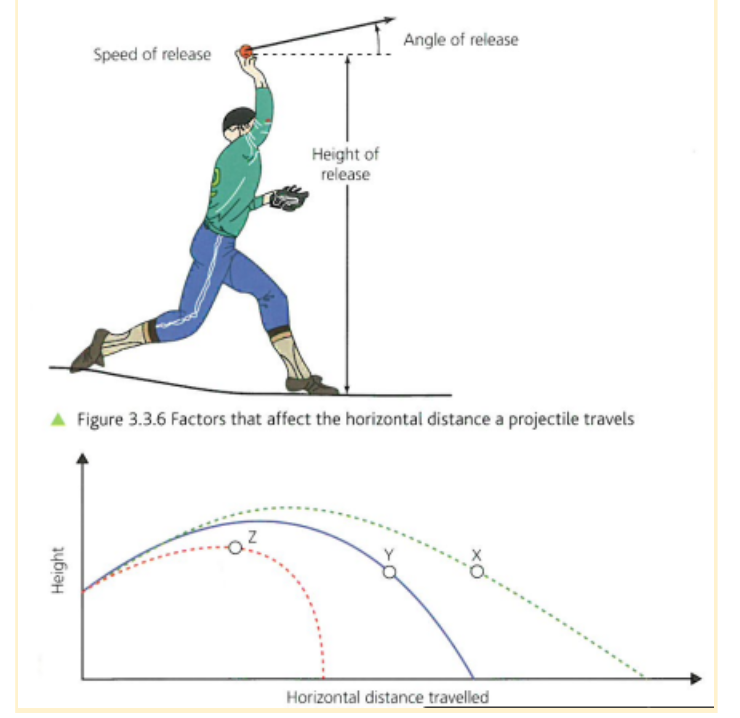
How speed of release affects horizontal distance travelled
Due to newton's second law of motion :
the greater force applied to the projectile, the greater change in momentum and therefore the acceleration of the projectile in the air
The greater the outgoing speed of the projectile the further it will travel
How angle of release affects horizontal distance travelled
90° → accelerate vertically upward and travel 0 m
45° → optimal angle to optimise horizontal distance
Greater than 45° → the projectile reaches peak height too quickly and rapidly returns to the ground
Less than 45° → the projectile does not achieve sufficient height to maximise the flight time
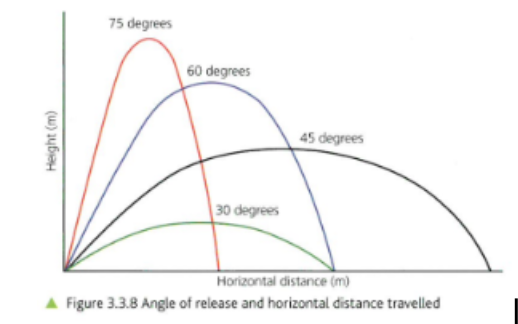
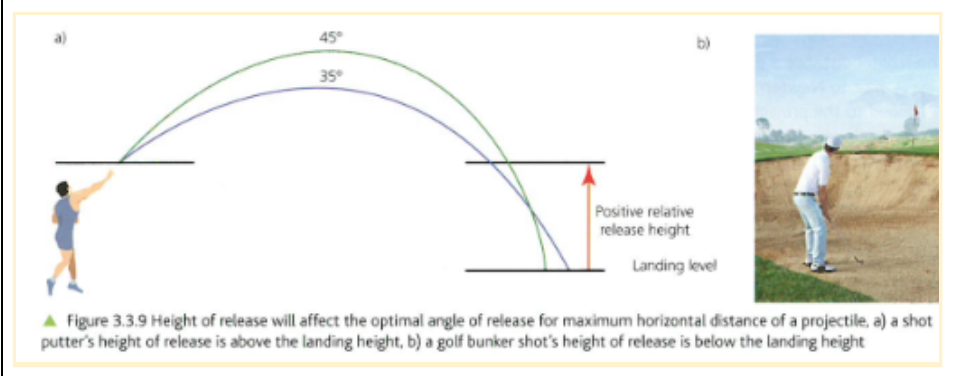
Height of release and horizontal distance : landing = starting height
45° → optimal angle to optimise horizontal distance if landing height and starting height are equal
Height of release and horizontal distance : landing below starting height
optimal angle is less than 45 as the projectile already has an increased flight time due to increased height of release
E.g javelin
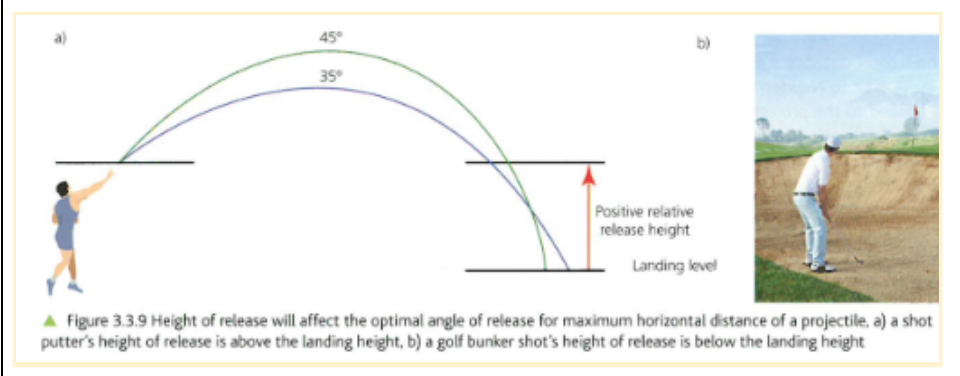
Height of release and horizontal distance : landing above starting height
optimal angle of release is more than 45 as the projectile needs an increased slight time to overcome the obstacle
Golf
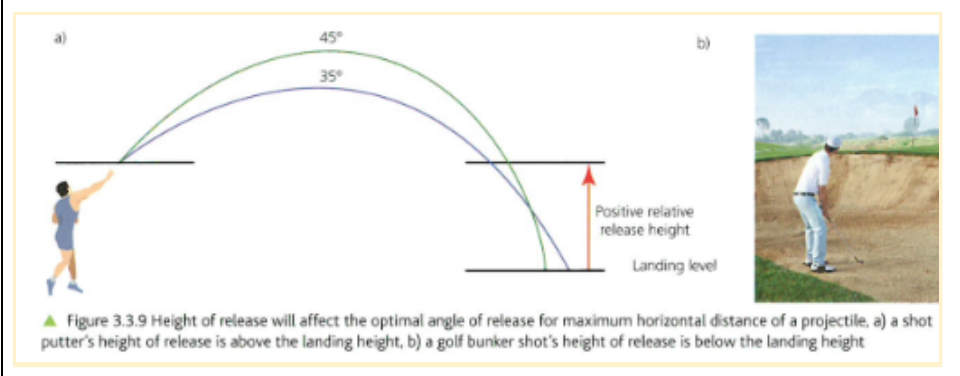
parabolic flight path
a flight path symmetrical about its highest point caused by the dominant weight force
e.g shot put

non-parabolic flight paths
a flight path asymmetrical about its highest point caused by the dominant force of air resistance on the projectile
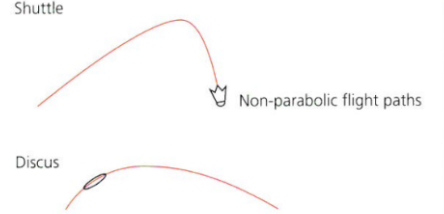
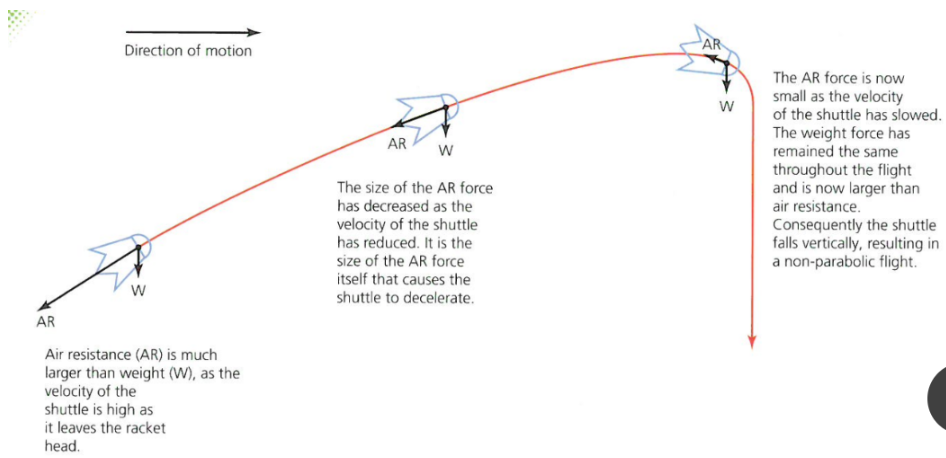
flight path of a shuttle cock initial
air resistance is much larger than weight
the velocity of the shuttle is high as it leaves the racket head
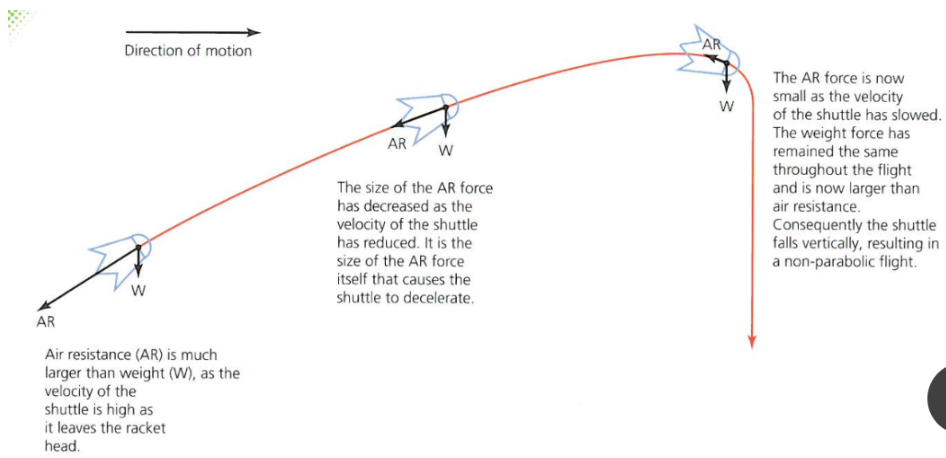
flight path of a shuttle cock mid flight
the size of AR force has decreased as
the velocity of the shuttle has reduced
it is the size of the AR force that causes the shuttle to decelerate
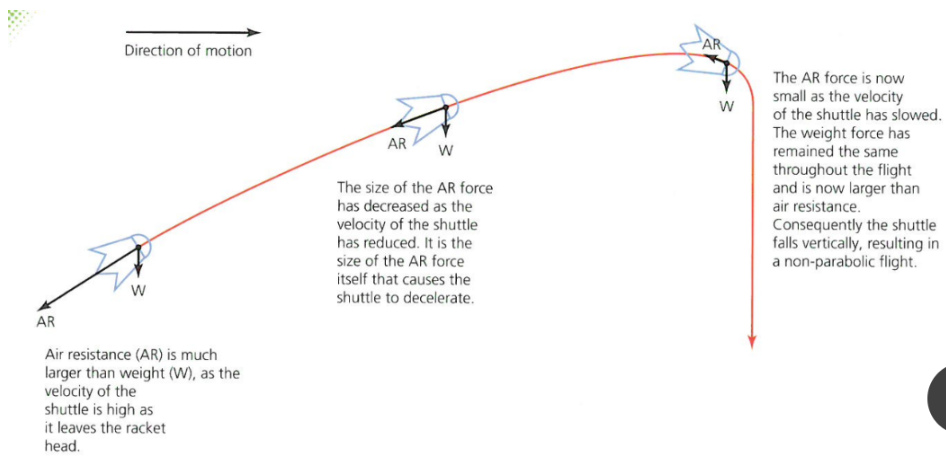
flight path of a shuttle cock landing
the AR force is now small as the velocity has decreased
the weight force has remained the same and is now larger than air resistance
the shuttle falls vertically resulting in a non-parabolic flight path
resultant force
the sum of all forces acting
net force
resultant force shows the acceleration of a projectile and direction in which the acceleration occurs
also shows flight Path
Resultant force : shot put
resultant force is closer to weight arrow
weight is dominant force
flight path is parabolic
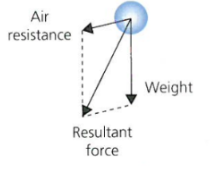
Resultant force : shuttle cock
if resultant force arrow is closer to the air resistance arrow
air resistance is dominant
non parabolic flight path
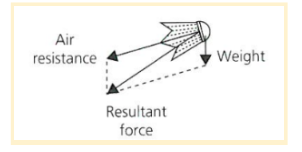
steps for drawing resultant force
Draw a free body diagram showing the forces of weight and air resistance
Adding dotted parallel lines to the weight and air resistance arrows to create a parallelogram
Draw a diagonal line from the origin of weight and air resistance (COM) to the opposite corner of the parallelogram with a double arrow labelled the resultant force
Bernoulli principle
creation of an additional lift force on a projectile in flight resulting from bernouill’s conclusion that
the higher velocity of air flow the lower the surrounding pressure
lift force
an additional force created by a pressure gradient forming on opposing surfaces of an aerofoil moving through a fluid
benefits of an additional lift force
increases time a projectile spends in the air
extends flight path
larger horizontal distance covered
e.g javelin and ski jumping
Relationship of velocity and pressure
pressure decreases as velocity increases
Aerofoil shape and Bernoulli: general
As the aerofoil moves through the air, air is forced to part and flow at different velocities above and below the projectile to meet at the same point behind
This affects pressure of air flow above and below the aerofoil and a pressure gradient forms to provide an additional lift force
air moves from an area of high pressure to an area of low pressure

Aerofoil shape and Bernoulli: curved top surface
forces air to travel a further distance
high velocity
low pressure zone
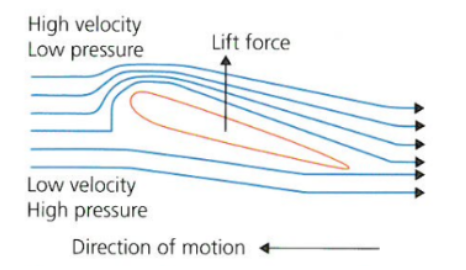
Aerofoil shape and Bernoulli: flat bottom surface
air flows a shorter distance
lower velocity
high pressure zone is created
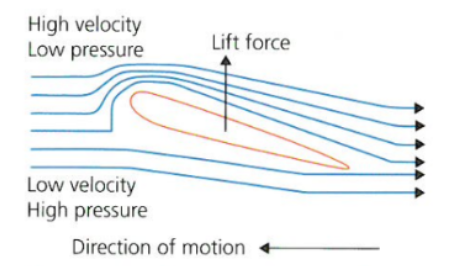
angle of attack
the most favourable angle of release for a projectile to optimise lift force due to the bernouilli principle
17° to act as an aerofoil to maximise bernoulli's lift force in flight
free body diagram showing effect of lift force
vertical force
weight - lift force

downward lift force
Aerofoil shape is inverted
E.g an F1 car and track cycling
Used to increase the downward force that holds to car or bike to the track
Area of low pressure is created below the car and are of high pressure created above,so air moves down a pressure gradient and provides the downward lift force
magnus effect
creation of an additional magnus force on a spinning projectile which deviates from the flight path
magnus force
a force created from a pressure gradient on opposing surfaces of a spinning body moving through the air
sidespin: hook
eccentric force applied right of the COM
spins left around the longitudinal axis
swerves projectile left
sidespin: slice
eccentric force applied left of the COM
spins right around the longitudinal axis
swerves projectile right
how is spin created
applying an eccentric force outside the centre of mass
magnus effect: general
Magnus effect works on the same principle as bernoulli
The way the projectile spins determines the direction, velocity and pressure of air flow around it
A pressure gradient is formed either side of the spinning projectile and an additional magnus force is created which deviates the flight path
This form of spins creates a non parabolic flight path
4 types of spin
top spin
back spin
sidespin : hook
sidespin: slice
top spin
eccentric force applied above COM
spins downwards around the transverse axis
shortens flight path
back spin
eccentric force applied below COM
spins upwards around the transverse axis
lengthens flight path
topspin + additional magnus force : upper surface
rotates opposing motion of oncoming air
low velocity of air flow
high pressure zone is created
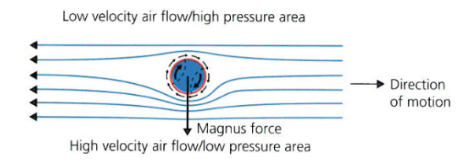
topspin + additional magnus force : lower surface
rotates with motion of oncoming air
high velocity of air flow
low pressure zone is created
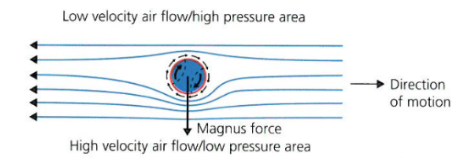
topspin + additional magnus force : effect
a pressure gradient forms
additional magnus force is created as air moves down a pressure gradient
shortens flight path
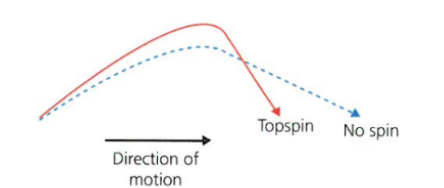
backspin and a free body diagram
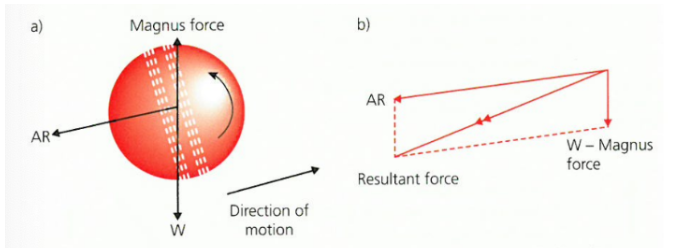
Hook + additional magnus force : left side of ball
Air flow opposes motion
Ball rotates to the left with the air flow
High velocity → low pressure
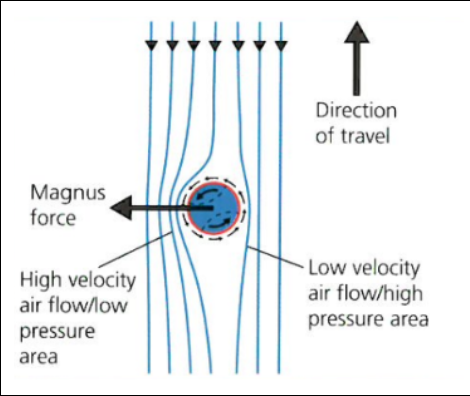
Hook + additional magnus force : right side of ball
Ball rotates against air flow on the right side resisting air flow
low velocity → high pressure
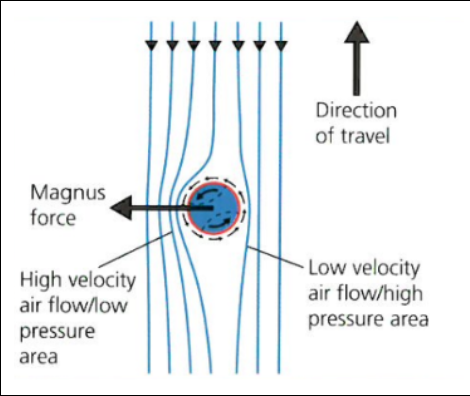
Hook + additional magnus force : effect
Pressure gradient is formed
Magnus force acts to deviate flight path to the left

Slice + additional magnus force : right side of ball
rotates with air flow
high velocity
low pressure

Slice + additional magnus force : left side of ball
rotates against air flow
low velocity
high pressure

Slice + additional magnus force : effect
Pressure gradient is formed
air moves from left to right
Magnus force acts to deviate the flight path to the right

benefits of topspin
can hit the ball harder and ball still lands in court
hit the ball higher and still lands in court
deceive opponent as ball appears to be going out
decreased angle on bounce